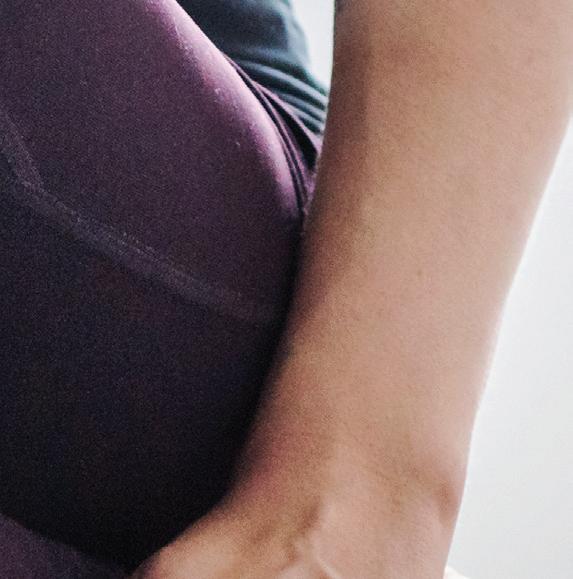
5 minute read
HELP FOR INTIMATE PAIN
HELP FOR
INTIMATE PAIN
















PHYSICAL THERAPY ENABLED ONE PATIENT TO OVERCOME AN EMBARRASSING CONDITION—FAST.
Jess*, 21, had a very personal problem: She experienced pain every time she had intercourse . Rather than 2019. As the two spoke, Dr. Mehta realized the young woman’s problems extended beyond painful sex. “Jess had a history of worked on her abdominal muscles,” she says. “We released the fascia, the tissue that covers the muscles. If the abdominal suff er in silence, she mentioned it to her bed-wetting as a child,” she recalls. “She muscles are in spasm, then the bladder gynecologist, who referred Jess to the became continent at age 12, but she still wet can’t relax and the patient feels the Pelvic Health Program at Robert Wood her bed about one to three times a month.” frequent urge to urinate.” Dr. Mehta also Johnson University Hospital (RWJUH) Jess also experienced the urge to urinate used specialized techniques to relax the Hamilton. Located in the RWJ Hamilton frequently—some days, every 30 minutes muscles surrounding the urethra, the Center for Health & Wellness, the program and one to two times per night. tube that carries urine out of the body. provides treatment Dr. Mehta evaluated Jess’s pelvic and In addition, Dr. Mehta helped for bladder, bowel abdominal muscles. She found that Jess had Jess modify her diet to avoid bladder and pelvic fl oor moderate pain and spasms in her hip, lower irritants, which lead to frequent conditions. abdominal muscles and pelvic fl oor muscles. urination. Caffeine, carbonated Rachna Mehta, “Problems with the pelvic fl oor muscles can beverages, tea and spicy foods can be DPT, CIMT, OCS, lead to pain during intercourse as well as the problematic, she says. Dr. Mehta also PRPC, a physical need to urinate frequently,” says Dr. Mehta. encouraged Jess to “retrain” her bladder therapist who’s an to stop her frequent bathroom trips. “She expert in pelvic HANDS-ON HEALING recommended urinating every two to rehabilitation, saw Dr. Mehta decided Jess could benefit three hours,” says Jess. RACHNA MEHTA, DPT, Jess, who’s a junior in from abdominal massage. “Using handsJess also learned how to perform hip CIMT, OCS, PRPC college, in November on, manual therapy techniques, we stretches, squats and yoga poses, which







VIRTUAL REHAB


While RWJ Rehab is open for inperson visits, patients may have the option to receive treatment via telehealth. Contact your preferred site to schedule your next appointment.
help to relax and stretch the pelvic floor muscles. “This decreases the need to urinate and reduces discomfort during sex,” says Dr. Mehta. She also taught Jess Kegel exercises—in which the pelvic floor muscles are tightened and then relaxed— to strengthen them.

QUICK RESULTS
Jess saw Dr. Mehta twice a week for about an hour. After just three or four visits, Jess noticed a significant improvement in her symptoms. “My university classes last about 90 minutes, and sometimes I would get up two or three times to go to the bathroom,” she recalls. “Now, I can sit through a lecture comfortably.”
About 10 days after her therapy began, Jess wasn’t experiencing any pelvic pain and was sleeping through the night. Since December, she hasn’t had any pain with intercourse, either. “I noticed an improvement in my symptoms very quickly,” says Jess. “My advice to anyone suffering from pelvic problems is not to be too embarrassed to ask for help.” Jess did so well that Dr. Mehta discharged her from therapy in March. “I’ve benefited from the program tremendously,” says Jess. “It’s improved my quality of life.”

* NAME CHANGED TO PROTECT PRIVACY.
Find out how rehab can change your life. For more information, visit www.rwjrehab.com.
REAPING THE BENEFITS OF REHAB
Rehabilitation can help patients with a variety of medical problems, says Pamela Randolph, DPT, Director of Rehabilitation Services at Robert Wood Johnson University Hospital (RWJUH) Hamilton. • ORTHOPEDIC CONDITIONS.
“Physical therapy is often the first treatment patients try before having surgery,” says Dr.
Randolph. “If a person suffers from movement dysfunction or a muscle imbalance, for instance, we can correct those to prevent surgery. We also provide therapy for those who do have surgery to improve their outcome.”
• NEUROLOGICAL CONDITIONS,
SUCH AS MULTIPLE SCLEROSIS,
PARKINSON’S DISEASE AND
MIGRAINES. These patients can benefit from physical therapy, occupational therapy or speech therapy—or all three.
• PELVIC PAIN, INCONTINENCE
AND CONSTIPATION. “We have expanded our program to include both male and female patients,” says Dr. Randolph.
“Our pelvic floor therapists use many different techniques, including biofeedback, manual therapy and patient education.” • CANCER. “Rehab helps cancer patients improve their endurance and strength during or after their treatment,” says Dr. Randolph.
Therapists can also help ease the symptoms of lymphedema, a complication that can occur during treatment. • BALANCE PROBLEMS. Patients who have trouble with balance or suffer from conditions like vertigo can benefit from vestibular rehabilitation.










